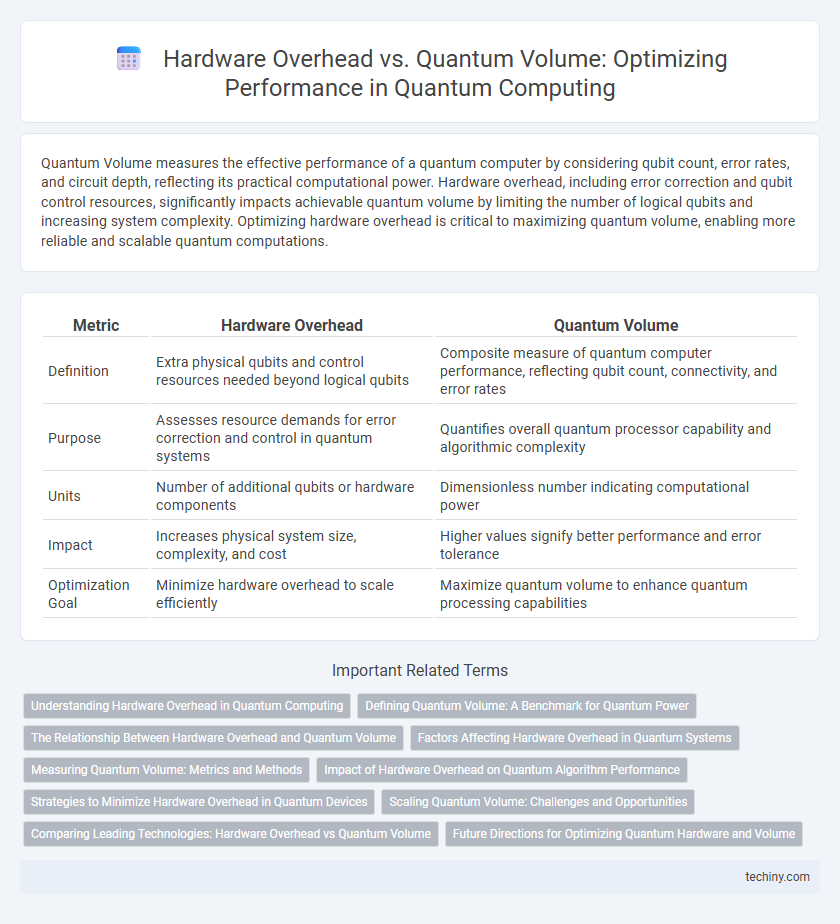Quantum Volume measures the effective performance of a quantum computer by considering qubit count, error rates, and circuit depth, reflecting its practical computational power. Hardware overhead, including error correction and qubit control resources, significantly impacts achievable quantum volume by limiting the number of logical qubits and increasing system complexity. Optimizing hardware overhead is critical to maximizing quantum volume, enabling more reliable and scalable quantum computations.
Table of Comparison
| Metric | Hardware Overhead | Quantum Volume |
|---|---|---|
| Definition | Extra physical qubits and control resources needed beyond logical qubits | Composite measure of quantum computer performance, reflecting qubit count, connectivity, and error rates |
| Purpose | Assesses resource demands for error correction and control in quantum systems | Quantifies overall quantum processor capability and algorithmic complexity |
| Units | Number of additional qubits or hardware components | Dimensionless number indicating computational power |
| Impact | Increases physical system size, complexity, and cost | Higher values signify better performance and error tolerance |
| Optimization Goal | Minimize hardware overhead to scale efficiently | Maximize quantum volume to enhance quantum processing capabilities |
Understanding Hardware Overhead in Quantum Computing
Hardware overhead in quantum computing refers to the additional physical resources and error-correcting components required to maintain qubit coherence and operational fidelity. This overhead significantly impacts the achievable quantum volume, a metric combining the number of qubits, gate fidelity, and circuit depth to measure computational power. Minimizing hardware overhead through advanced qubit design and error mitigation techniques directly enhances quantum volume, enabling more complex and reliable quantum algorithms.
Defining Quantum Volume: A Benchmark for Quantum Power
Quantum Volume measures the overall power of a quantum computer by evaluating error rates, qubit connectivity, and circuit depth in a comprehensive benchmark. This metric reflects the hardware overhead needed to achieve reliable quantum computations, balancing qubit quality and quantity. Higher Quantum Volume indicates greater capability to run complex algorithms with lower error probabilities, making it a crucial standard for hardware efficiency and scalability.
The Relationship Between Hardware Overhead and Quantum Volume
Quantum volume measures a quantum computer's overall performance by balancing qubit count, connectivity, and error rates, which directly impacts hardware overhead requirements. Increasing quantum volume necessitates more sophisticated qubit control, error correction protocols, and physical resources, thereby raising hardware overhead. Optimizing hardware overhead while maximizing quantum volume is crucial for scalable, efficient quantum computing architectures.
Factors Affecting Hardware Overhead in Quantum Systems
Hardware overhead in quantum computing is influenced by factors such as qubit coherence times, error rates, and gate fidelity, which determine the need for error correction protocols and redundant qubits. The physical architecture, including qubit connectivity and control electronics, also impacts the scalability and complexity of the hardware. These elements directly affect the achievable quantum volume, representing the effective performance of a quantum system despite hardware limitations.
Measuring Quantum Volume: Metrics and Methods
Measuring quantum volume involves evaluating qubit count, gate fidelity, connectivity, and error rates to provide a holistic performance metric beyond raw qubit numbers. Hardware overhead, including error correction resources and control electronics, directly impacts achievable quantum volume by influencing circuit depth and error resilience. Quantum volume serves as a critical benchmark for comparing hardware architectures, guiding optimization of resource allocation for scalable quantum processors.
Impact of Hardware Overhead on Quantum Algorithm Performance
Hardware overhead in quantum computing, encompassing control electronics and error correction resources, directly affects quantum volume by limiting the number of effective qubits and circuit depth achievable. Increased hardware overhead reduces the fidelity of quantum operations, thereby diminishing the overall performance of quantum algorithms and constraining scalability. Optimizing hardware designs to minimize overhead is crucial for enhancing quantum volume and improving the execution of complex quantum algorithms.
Strategies to Minimize Hardware Overhead in Quantum Devices
Minimizing hardware overhead in quantum devices involves optimizing qubit connectivity and error correction protocols to enhance quantum volume efficiently. Advanced techniques like modular architectures and scalable qubit designs reduce resource demands while maintaining coherence times and gate fidelities. Implementing dynamic qubit allocation and error mitigation strategies further balances hardware complexity with computational power, driving practical quantum computing advancements.
Scaling Quantum Volume: Challenges and Opportunities
Scaling quantum volume requires addressing hardware overhead through advances in qubit coherence, gate fidelity, and error correction techniques. Balancing the increase in qubit count with system complexity poses significant engineering challenges, as maintaining low error rates becomes increasingly difficult. Innovations in scalable architectures and modular quantum processors offer opportunities to optimize hardware efficiency while maximizing quantum volume growth.
Comparing Leading Technologies: Hardware Overhead vs Quantum Volume
Leading quantum computing technologies balance hardware overhead and quantum volume to enhance computational efficiency. Superconducting qubits demand substantial hardware overhead but achieve considerable quantum volume through improved coherence times and gate fidelities. In contrast, trapped ion systems offer lower hardware overhead with high quantum volume due to precise control and scalability, influencing their suitability for complex quantum algorithms.
Future Directions for Optimizing Quantum Hardware and Volume
Emerging quantum hardware designs aim to reduce physical qubit count while enhancing error correction to maximize quantum volume, integrating scalable architectures like superconducting circuits and trapped ions. Advances in coherent control and qubit connectivity improve gate fidelity and circuit depth, crucial for practical quantum algorithms. Future optimization focuses on hybrid systems combining qubit types and error-mitigation techniques to balance hardware overhead with increased computational capacity.
Hardware Overhead vs Quantum Volume Infographic

 techiny.com
techiny.com